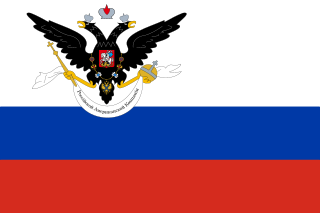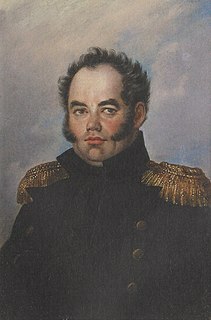Related Research Articles

The Russian colonization of North America covers the period from 1732 to 1867, when the Russian Empire laid claim to northern Pacific Coast territories in the Americas. Russian colonial possessions in the Americas are collectively known as Russian America. Russian expansion eastward began in 1552, and in 1639 Russian explorers reached the Pacific Ocean. In 1725, Emperor Peter the Great ordered navigator Vitus Bering to explore the North Pacific for potential colonization. The Russians were primarily interested in the abundance of fur-bearing mammals on Alaska's coast, as stocks had been depleted by over hunting in Siberia. Bering's first voyage was foiled by thick fog and ice, but in 1741 a second voyage by Bering and Aleksei Chirikov made sight of the North American mainland.

Unalaska is the chief center of population in the Aleutian Islands. The city is in the Aleutians West Census Area, a regional component of the Unorganized Borough in the U.S. state of Alaska. Unalaska is located on Unalaska Island and neighboring Amaknak Island in the Aleutian Islands off mainland Alaska. The population was 4,254 at the 2020 census, which is 81% of the entire Aleutians West Census Area. Unalaska is the second largest city in the Unorganized Borough, behind Bethel.

Alexander Andreyevich Baranov, sometimes spelled Aleksandr or Alexandr and Baranof, was a Russian trader and merchant, who worked for some time in Siberia. He was recruited by the Shelikhov-Golikov Company for trading in Russian America, beginning in 1790 with a five-year contract as manager of the outpost. He continued to serve past the end date of his contract.

The Russian-American Company Under the High Patronage of His Imperial Majesty was a state-sponsored chartered company formed largely on the basis of the United American Company. Emperor Paul I of Russia chartered the company in the Ukase of 1799. It had the mission of establishing new settlements in Russian America, conducting trade with natives, and carrying out an expanded colonization program.

Ludwig Karl August von Hagemeister was a Russian naval officer who held the rank of Captain of the 1st rank in the Imperial Russian Navy. He was a maritime explorer of Alaska and the Pacific Ocean, and served briefly in 1817-1818 as the second Chief Manager of the Russian-American Company.

The Battle of Sitka was the last major armed conflict between Russians and Alaska Natives, and was initiated in response to the destruction of a Russian trading post two years before. The primary combatant groups were the Kiks.ádi Clan of Sheetʼká Xʼáatʼi of the Tlingit nation and agents of the Russian-American Company assisted by the Imperial Russian Navy.

Russian America was the name for the Russian Empire's colonial possessions in North America from 1799 to 1867. It consisted mostly of present-day Alaska in the United States, but also included small outposts in California, including Fort Ross, and three forts in Hawaii, including Russian Fort Elizabeth. Settlements were concentrated in Alaska, including the capital, Novo-Arkhangelsk, which is now Sitka.

Indian River is a roughly eight-mile long watershed that flows through the community of Sitka on Baranof Island in the Alexander Archipelago of Southeast Alaska.

Sitka Sound is a body of water near the city of Sitka, Alaska. It is bordered by Baranof Island to the south and the northeast, by Kruzof Island to the northwest and by the Pacific Ocean to the southwest. During the early 19th century it was a major locus of the maritime fur trade.

Yakobi Island is an island in the Alexander Archipelago of southeastern Alaska, United States. It lies to the south of Cross Sound and just off the western edge of Chichagof Island, separated from it by Lisianski Inlet and Lisianski Strait. The island has a land area of 82.37 sq mi (213.3 km2) and no permanent resident population.

Unga Island is the largest of the Shumagin Islands off the Alaska Peninsula in southwestern Alaska, United States. The island has a land area of 170.73 sq mi (442.188 km2), making it the 36th largest island in the United States. As of the 2000 census, it had a permanent population of one.

Nora Marks Keixwnéi Dauenhauer was a Tlingit poet, short-story writer, and Tlingit language scholar from Alaska. She won an American Book Award for Russians in Tlingit America: The Battles of Sitka, 1802 And 1804. Nora was Alaska State Writer Laureate from 2012 - 2014.

Richard Dauenhauer was an American poet, linguist, and translator who married into, and subsequently became an expert on, the Tlingit nation of southeastern Alaska. He was married to the Tlingit poet and scholar Nora Marks Dauenhauer. With his wife and Lydia T. Black, he won an American Book Award for Russians in Tlingit America: The Battles of Sitka, 1802 And 1804
Phoenix was the first ship built in Russian America, for the Shelikhov-Golikov Company, a precursor of the Russian–American Company (RAC). James George Shields, a British mariner in the employ of the Russian Navy, directed her construction, using mainly local materials. The ship was launched at Voskresenskaia on Resurrection Bay in the summer of 1794.

Castle Hill also known as the American Flag-Raising Site and now as the Baranof Castle State Historic Site, is a National Historic Landmark and state park in Sitka, Alaska. The hill, providing a commanding view over the city, is the historical site of Tlingit and Russian forts, and the location where Russian Alaska was formally handed over to the United States in 1867. It is also where the 49-star United States flag was first flown after Alaska became a state in 1959.
Evstratii Ivanovich Delarov was a Greek-born mariner who served with several Russian maritime fur trade companies in Russian America. He was born in Ottoman Macedonia. He was the first documented Greek explorer and merchant to arrive in Alaska.

Lydia T. Black was an American anthropologist. She won an American Book Award for Russians in Tlingit America: The Battles of Sitka, 1802 And 1804.
Semyon Ivanovich Yanovsky was a Russian naval officer who was appointed in late 1818 as Chief Manager of the Russian-American Company, serving into 1820. He had traveled to Kodiak Island with his commanding officer, Ludwig von Hagemeister, who appointed him to the post. The Russian-American Company conducted trading and colonization based in present-day Alaska. Yanovsky was replaced in 1820 by Matvey Ivanovich Muravyev, who had been selected by the Board of the RAC.

Matvey Ivanovich Muravyev was a Russian explorer and officer of the Russian Imperial Navy. In 1820 he was appointed by the Russian-American Company as Chief Manager, based in present-day Alaska and responsible for the company's colonization and trading efforts.
Lydia was a US merchant ship that sailed on maritime fur trading ventures in the early 1800s. In December 1813 it was sold to the Russian–American Company and renamed Il'mena, also spelled Ilmena and Il'men'. As both Lydia and Il'mena it was involved in notable events. Today it is best known for its role in an 1814 massacre of the Nicoleño natives of San Nicolas Island, which ultimately resulted in one Nicoleño woman, known as Juana Maria, living alone on the island for many years. These events became the basis for Scott O'Dell's 1960 children's novel Island of the Blue Dolphins and the 1964 film adaptation Island of the Blue Dolphins.
References
- Black, Lydia T. (2004), Russians in Alaska: 1732-1867, University of Alaska Press, ISBN 1-889963-04-6 .
- Black, Lydia T.; Dauenhauer, Nora; Dauenhauer, Richard (2008), Russians in Tlingit America, University of Washington Press, ISBN 978-0-295-98601-2 .
- Emmons, George Thornton; De Laguna, Frederica (1991), The Tlingit Indians , University of Washington Press, ISBN 978-0-295-97008-0 .

